This post may contain affiliate links. Please read our disclosure policy.
The mingling of the bread’s subtle sweetness and aromatic pandan flavor with the rich, creamy coconut flavor is a symphony that dances on the taste buds.

What is pani popo?
Pani Popo is a delicious and beloved dish from Samoa that consists of sweet, coconut-flavored buns baked in a rich coconut milk sauce. The name “Pani Popo” is derived from the Samoan words “pani,” which means coconut, and “popo,” which refers to the aromatic scent of coconut cream. This dish is a popular treat in Samoan cuisine and is often enjoyed during special occasions, family gatherings, and celebrations. I added a little Southeast Asian twist to the dish by infusing pandan flavor, which undoubtedly, pairs well with coconut.
Ingredients and substitutions
1. Bread flour
I use bread flour with protein content of about 12.7%. You can use all-purpose flour, but you want to cut back on the pandan juice by about 10% and adjust the amount as needed
2. All-purpose flour
I usually use unbleached all-purpose flour. You can use bleached all-purpose flour if that’s all you have
3. Milk powder
I usually use non-fat milk powder, because that’s what is mostly available. You can use full-fat milk powder. Milk powder help to keep the dough moist. You can omit if you don’t have any
4. Salt
I use fine sea salt. I don’t recommend omitting salt as the flavor of the bread will taste bland
5. Sugar
I use granulated sugar. You can use caster sugar too. We want the dough to be slightly sweet, but not too much since we are serving it with sweet coconut cream sauce
6. Instant yeast
I prefer to use instant yeast because it’s more convenient. If you use active dry yeast, be sure to bloom it in some pandan juice and small pinch of sugar
7. Pandan juice and pandan essence
I use homemade pandan juice and added store-bought pandan essence so the color is a bit more vibrant
8. Coconut cream
I use canned coconut cream. Coconut cream is thick and like a cream. Do not use coconut milk that comes in a carton, made for beverage, that’s not the right coconut milk to be used in this recipe
9. Butter
I use unsalted butter. If you use salted butter, you can omit the salt in the recipe
10. Cornstarch
The cornstarch is added to thicken the coconut cream sauce slightly
11. Vanilla extract
I use real vanilla extract. Avoid the imitation vanilla extract

Pani Popo (Samoan Coconut Buns) – Pandan Flavor
Ingredients
- 250 g bread flour (12.7% protein content)
- 50 g all-purpose flour
- 10 g milk powder
- 4 g fine sea salt
- 30 g sugar
- 4 g instant yeast
- 100 g pandan juice plus more as needed
- ½ tsp pandan essence optional
- 70 g canned coconut cream
- 30 g unsalted butter softened
Coconut cream sauce:
- 165 g canned coconut cream
- 30 g sugar or more to your taste
- ¼ tsp salt
- 2 tsp cornstarch
- 1 tsp vanilla extract
Instructions
Prepare the dough:
- Add all ingredients for the dough except for the butter. Use the dough hook to stir the mixture a bit so the flour won't fly around when you start the mixer. Knead on the lowest speed for 2-3 minutes and then increase to speed 2 and knead for 3 minutes and then speed 4 for another 3 minutes or until it forms a dough that clears the side of the bowl, but not smooth yet
- Add the softened butter and knead on speed 2 for about 2-3 minutes and then increase speed to 4 and knead for 5 minutes or until the dough is soft, smooth, elastic, and slightly sticky to the touch. Don't be tempted to add extra flour.
- It is important that the dough is soft, meaning, enough hydration. This will ensure you get a soft fluffy bread texture for more than 24 hours. If the dough feels firm, don't be afraid to add a bit more pandan juice, one teaspoon at a time and knead until you get a soft smooth dough.
First proofing:
- Lightly oil your hands and a bowl. Transfer the dough to the bowl. Cover with a kitchen towel or with plastic wrap, and let rise in a warm place for about 45 minutes to 1 hour, or until double in volume. if it's colder, it may take longer to proof the dough
Prepare the coconut cream sauce:
- While waiting, put the coconut cream, sugar, salt, and cornstarch in a saucepan. Use a whisk to combine until you don't see the cornstarch any more
- Put the pan on the stove top over medium-low heat and keep whisking. The sauce will start to thicken slightly. Have a taste and see if it's sweet enough for you. You can add more sugar if you prefer it sweeter. Cook until it just about to come to a simmer. Don't let it boil or the coconut cream may separate. Remove from the heat. Stir in the vanilla extract. Let it cool down while waiting for the dough to rise
Shaping:
- You can use 8 x 8 square pan or 8 or 9 inch round pan. Line the pan with parchment paper with some hang over on the sides so you can easily pull it out from the pan later
- Knock out all the gas by giving it some kneading. Divide the dough into 9 equal portions. Keep them covered and work with one dough at a time
- Flatten the dough slightly with your palm and then pull the edges towards the middle to form a tight dough ball. Place the dough on a prepared baking pan. Repeat with the rest of the dough
Final proofing:
- Cover and let them proof at a warm place until they are really puffy. This may take about 45 minutes to 1 hour. If it is colder where you are, it may take longer
- When you gently push on the dough, it should bounce back very slowly and leave some indentation. The dough is done proofing
- 5 minutes before the end of proofing, start preheating your oven to 375 F (190 C) for a conventional oven. For a convection oven, lower the temperature by 20 F or 15 C
Baking:
- Pour 1/2 of the coconut cream sauce over the proofed buns, covering the base. Brush some on top of the buns too
- Place the baking pan in the middle rack and bake for 20-25 minutes or until the top is nicely golden brown and a thermometer should register around 190 F (88 C) at the center of the bread. If the top gets too brown halfway, tent with an aluminum foil, shiny side up
Serve:
- Place the baking pan on a cooling rack and let it cool for about 5 minutes before serving
- Remove the buns from the baking pan by grabbing on the parchment paper. Serve them warm. Tear off the buns and drizzle with more coconut cream sauce. Heaven on earth!!
RECOMMEDED TOOLS
*Nutrition facts are just estimates and calculated using online tools*
How to bake pandan flavor pani popo buns
1. Add all ingredients for the dough except for the butter. Use the dough hook to stir the mixture a bit so the flour won’t fly around when you start the mixer. 
2. Knead on the lowest speed for 2-3 minutes and then increase to speed 2 and knead for 3 minutes and then speed 4 for another 3 minutes or until it forms a dough that clears the side of the bowl, but not smooth yet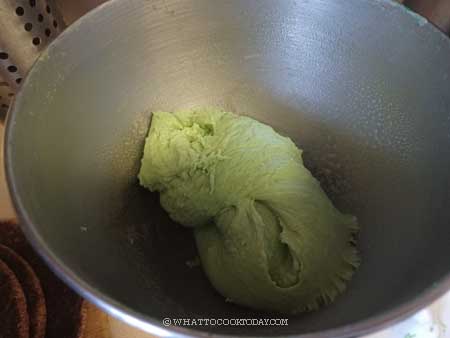
3. Add the softened butter and knead on speed 2 for about 2-3 minutes and then increase speed to 4 and knead for 5 minutes or until the dough is soft, smooth, elastic, and slightly sticky to the touch. Don’t be tempted to add extra flour.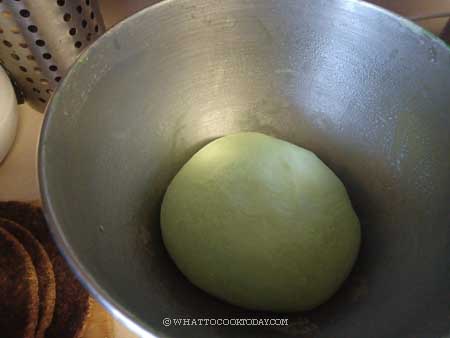
4. Lightly oil your hands and a bowl. Transfer the dough to the bowl. Cover with a kitchen towel or with plastic wrap, and let rise in a warm place for about 45 minutes to 1 hour, or until double in volume. if it’s colder, it may take longer to proof the dough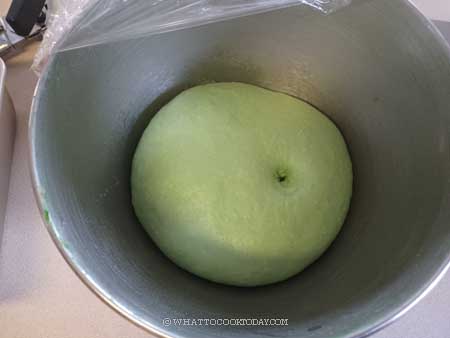
5. While waiting, put the coconut cream, sugar, salt, and cornstarch in a saucepan. Use a whisk to combine until you don’t see the cornstarch any more. Put the pan on the stove top over medium-low heat and keep whisking. 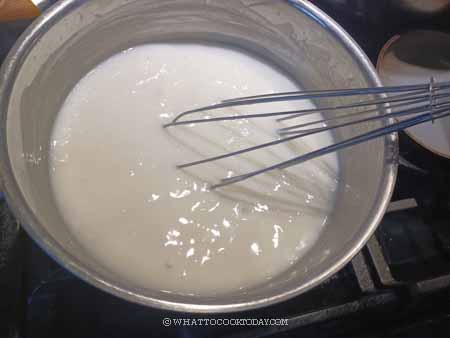
6. The sauce will start to thicken slightly. It coats the spatula. Have a taste and see if it’s sweet enough for you. You can add more sugar if you prefer it sweeter. Cook until it just about to come to a simmer. Don’t let it boil or the coconut cream may separate. Remove from the heat. Stir in the vanilla extract. Let it cool down while waiting for the dough to rise
7. You can use 8 x 8 square pan or 8 or 9 inch round pan. Line the pan with parchment paper with some hang over on the sides so you can easily pull it out from the pan later.
8. Knock out all the gas by giving it some kneading. Divide the dough into 9 equal portions. Keep them covered and work with one dough at a time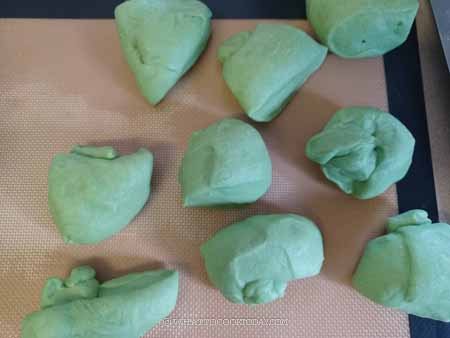
9. Flatten the dough slightly with your palm and then pull the edges towards the middle to form a tight dough ball. Place the dough on a prepared baking pan. Repeat with the rest of the dough
10. I do double batch here and divide them into several different pans to share with friends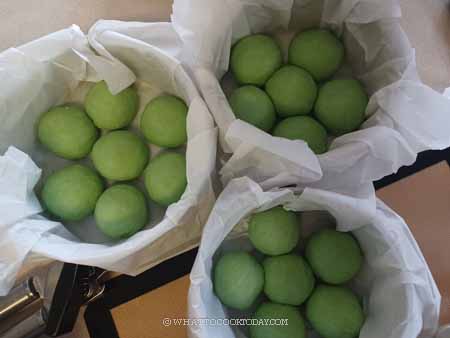
11. Cover and let them proof at a warm place until they are really puffy. This may take about 45 minutes to 1 hour. If it is colder where you are, it may take longer. When you gently push on the dough, it should bounce back very slowly and leave some indentation. The dough is done proofing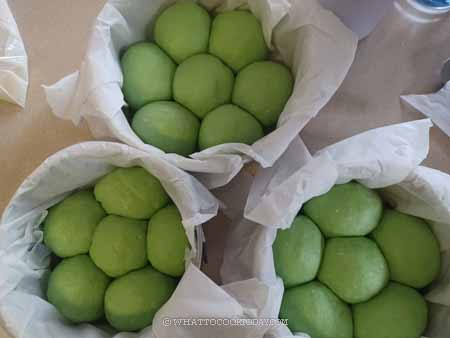
12. 5 minutes before the end of proofing, start preheating your oven to 375 F (190 C) for a conventional oven. For a convection oven, lower the temperature by 20 F or 15 C. Pour 1/2 of the coconut cream sauce over the proofed buns, covering the base. Brush some on the top of the buns too
13. Place the baking pan in the middle rack and bake for 20-25 minutes or until the top is nicely golden brown and a thermometer should register around 190 F (88 C) at the center of the bread. If the top gets too brown halfway, tent with an aluminum foil, shiny side up
14. Place the baking pan on a cooling rack and let it cool for about 5 minutes before serving. Remove the buns from the baking pan by grabbing on the parchment paper. Serve them warm. Tear off the buns and drizzle with more coconut cream sauce. Heaven on earth!!

How to store leftovers
1. Let the buns cool down completely. They can be kept in an air-tight container or ziplock bag for 2-3 days at room temperature. Keep the coconut cream sauce in the fridge however.
2. The buns stays soft for 2-3 days. If you prefer them warm, simply wrap them with an aluminum foil, reheat in the oven at 350 F for 8-10 minutes or until warm. You can reheat the cream sauce on the stove or microwave or serve the sauce cold if you like
Did you make this pani popo recipe?
I love it when you guys snap a photo and tag it to show me what you’ve made. Simply tag me @WhatToCookToday #WhatToCookToday on Instagram and I’ll be sure to stop by and take a peek for real!



